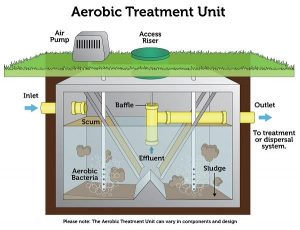Types of Septic Systems; Materials & Designs

While inspecting your septic system to determine if it needs to be pumped, repaired, or replaced, you may want to also research types of septic systems. Knowing what the different types of septic systems can help you to better understand your system as well as which is best for your needs. Therefore, before you set up your septic system installation let’s look at the two most common types of septic tanks.

Types Of Septic Systems: Materials
- Plastic Septic Tanks
- Crack resistant due to plastic being flexible
- Completely resistant to water-based corrosion
- Cheaper to buy and install
- Concrete Septic Tanks
- Durable – tanks are watertight and heavy duty
- Low susceptibility to damage during backfill, tree roots invasion, or temperature shifts, which provides low maintenance
- High effluent levels
In addition to the type of material the systems are built from, septic system designs and sizes vary widely based on several factors (household vs commercial property, soil type, slope of lot, lot size, local regulations).
Types Of Septic Systems: Design
- Conventional System
- Chamber System
- Drip Distribution System
- Aerobic Treatment Unit
- Mound Systems
- Recirculating Sand Filter System
- Evapotranspiration System
- Constructed Wetland System
- Cluster/Community System
Site and soil conditions generally determine the type of system that should be installed. Next you will find information on a few of the more common options:
1. Conventional Septic Systems:

- This is a wastewater treatment system consisting of a septic tank and a trench or bed subsurface wastewater infiltration system.
- A conventional septic system is typically installed at a single-family home or small business.
- The drain fields are built with a gravel/stone design.
- Effluent filters through the stone and is then further treated by microbes once it reaches the soil below the gravel/stone trench
- The general layout of this system covers a large footprint.
2. Chamber Septic Systems:

- Chamber septic systems are gravelless drain fields that consist of a series of connected chambers.
- The area around and above the chambers is filled with soil.
- Pipes carry wastewater from the septic tank to the chambers. In the chambers, the wastewater encounters the soil. Microbes on or near the soil treat the effluent.
- The chamber system serves as an alternative design to the gravel/stone system.
- The added advantage of this system is increased ease of delivery and construction.
- These systems are suited to areas with high groundwater tables, where the volume of influent to the septic system, and where plastic chambers are readily available, making for plastic septic tanks a viable option.
>
3. Drip Distribution Septic Systems:

- A drip distribution system has four main parts
- A pretreatment device
- A pump tank
- A filtering and flushing device
- Distribution tubing
- Pretreated effluent is applied to soil through a series of tubes equipped with emitters that allow a small amount of effluent into the soil at a time. This allows the effluent to be distributed more evenly over a large area.
- This system also requires electrical power.
Aerobic Treatment Unit:

- The aerobic treatment unit has the same processes as a municipal sewage plant, but on a smaller scale.
- Aerobic treatment is a biological process that uses oxygen to break down organic matter and remove other pollutants.
- The additional oxygen increases natural bacterial activity within the system that then provides additional treatment for nutrients in the effluent.
- Some aerobic systems may also have a pretreatment tank and a final treatment tank including disinfection to further reduce pathogen levels.
- This system is best used in small lots, areas that have inadequate soil conditions, where the water tables are too high, or where structures are too close to a body of water (contamination risk).
How Do I Maintain My Septic System?
- Pump your septic tank every 2-3 years.
- Have a septic tank inspection done every 3-5 year
Therefore, when inspecting your septic system, it is important to ensure that your professional is also inspecting other parts of the system (like the distribution box) as well as your leech fields.
What Are The Signs That Your Septic Tank Needs To Be Pumped?
- Slow drains
- Foul odor
- Pooling water
What Are The Signs That Your Septic System Needs To Be Replaced?
- Puddles in your yard
- Regular pipe backups
- Extra green grass
- Continued tank issues
- Failed water test
In conclusion, whether you are having a septic system installed for the first time, or you need your existing septic tank to be replaced, it is important to factor the above into your decision. Our professionals at Kulk’s Plumbing & Heating can assist in choosing from the different types of septic systems to determine which is best for your needs.
At Kulk’s Plumbing we provide septic system installation, septic tank replacement and diagnostic services.
In the event that you have an emergency, we offer 24 hour emergency plumbing.

